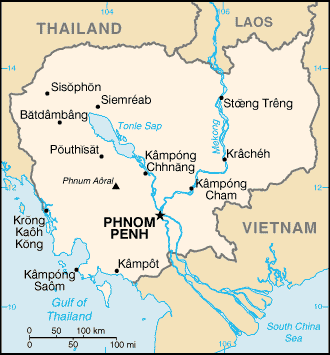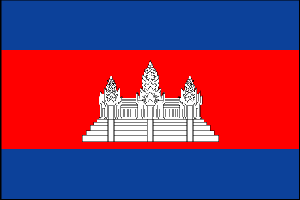
|
Cambodia
Background:
Following a five-year struggle, Communist Khmer Rouge forces captured Phnom
Penh in 1975 and ordered the evacuation of all cities and towns; over 1 million
displaced people died from execution or enforced hardships. A 1978 Vietnamese
invasion drove the Khmer Rouge into the countryside and touched off 13 years of
fighting. UN-sponsored elections in 1993 helped restore some semblance of
normalcy, as did the rapid diminishment of the Khmer Rouge in the mid-1990s. A
coalition government, formed after national elections in 1998, brought renewed
political stability and the surrender of remaining Khmer Rouge forces.
Location:
Southeastern Asia, bordering the Gulf of Thailand, between Thailand,
Vietnam, and Laos
Area: Total: 181,040 sq km, land: 176,520 sq km, water: 4,520 sq km.
Area - comparative: Slightly smaller than Oklahoma
Land boundaries: Total: 2,572 km, border countries: Laos 541 km, Thailand 803
km, Vietnam 1,228 km.
Coastline: 443 km.
Climate and Terrain:
Climate: Tropical; rainy, monsoon season (May to November); dry season
(December to April); little seasonal temperature variation.
Terrain: Mostly low, flat plains; mountains in southwest and north.
Elevation extremes: Lowest point: Gulf of Thailand 0 m, highest point: Phnum
Aoral 1,810 m.
Natural resources: Timber, gemstones, some iron ore, manganese, phosphates,
hydropower potential
People:
Population: 12,775,324.
Ethnic groups: Khmer 90%, Vietnamese 5%, Chinese 1%, other 4% .
Religions: Theravada Buddhist 95%, other 5%.
Languages: Khmer (official) 95%, French, English.
Government:
Government type: Multiparty democracy under a constitutional monarchy.
Capital: Phnom Penh.
Independence: 9 November 1953 (from France).
Economy overview:
Cambodia's economy slowed dramatically in 1997-98 due to the regional economic
crisis, civil violence, and political infighting. Foreign investment and
tourism fell off. In 1999, the first full year of peace in 30 years, progress
was made on economic reforms and growth resumed at 5%. GDP growth for 2000 had
been projected to reach 5.5%, but the worst flooding in 70 years severely
damaged agricultural crops, and high oil prices hurt industrial production, and
growth for the year is estimated at only 4%. In 2001, severe floods damaged an
estimated 15% of the area devoted to rice. Tourism now is Cambodia's fastest
growing industry, with arrivals up 34% in 2000 and up another 40% in 2001
before the September 11 terrorist attacks in the US.
GDP - composition by sector: agriculture: 50%, industry: 15%, services: 35%.
Statistics:
Telephones - main lines in use: 21,800.
Telephones - mobile cellular: 80,000.
Radio broadcast stations: AM 7, FM 3.
Radios: 1.34 million.
Television broadcast stations: 5.
Televisions: 94,000.
Internet users: 6,000.
Railways: Total: 603 km.
Highways: Total: 35,769 km, paved: 4,165 km, unpaved: 31,604 km.
Airports: 20 (2001)
Airports - with paved runways: 5, with unpaved runways: 15.
Return to Visiting Locations
|

